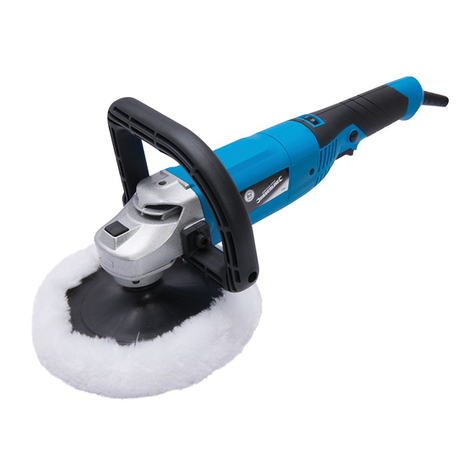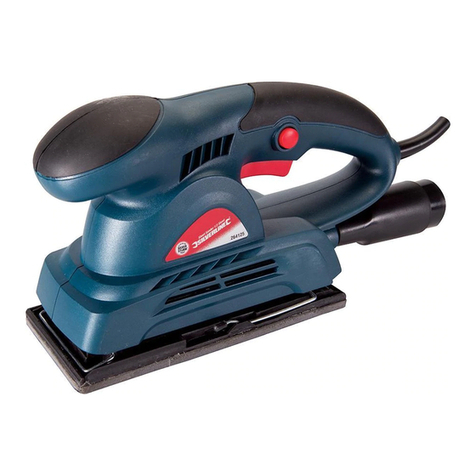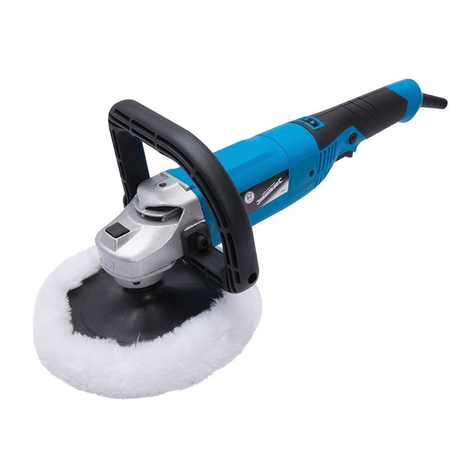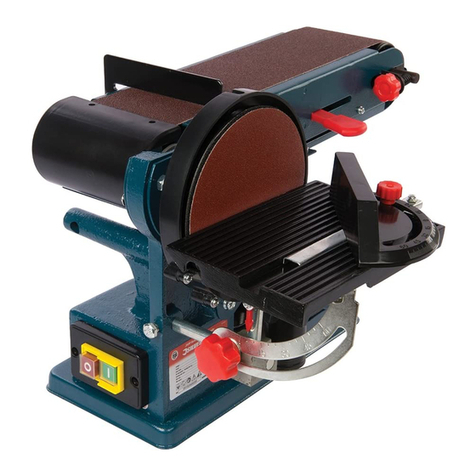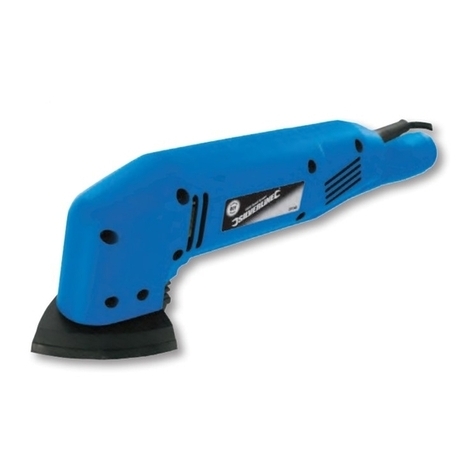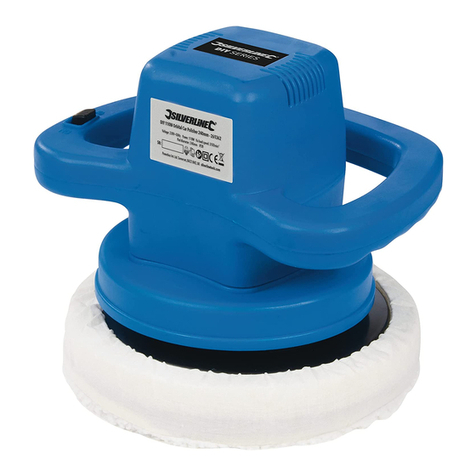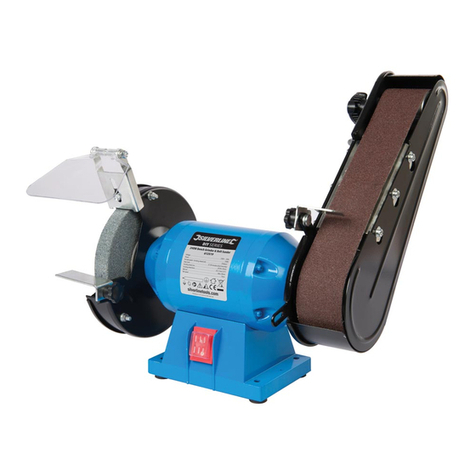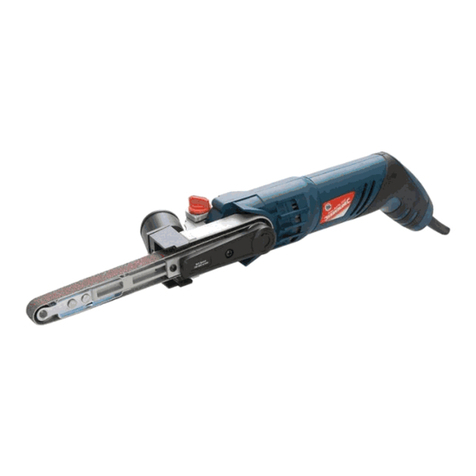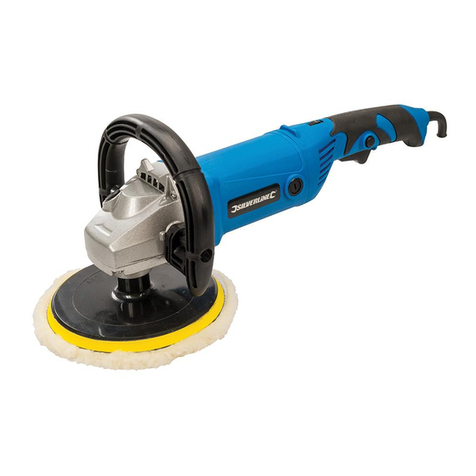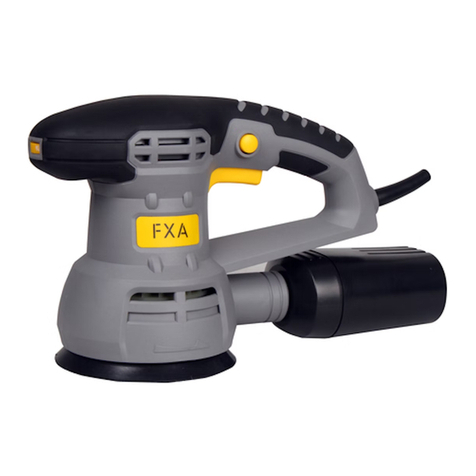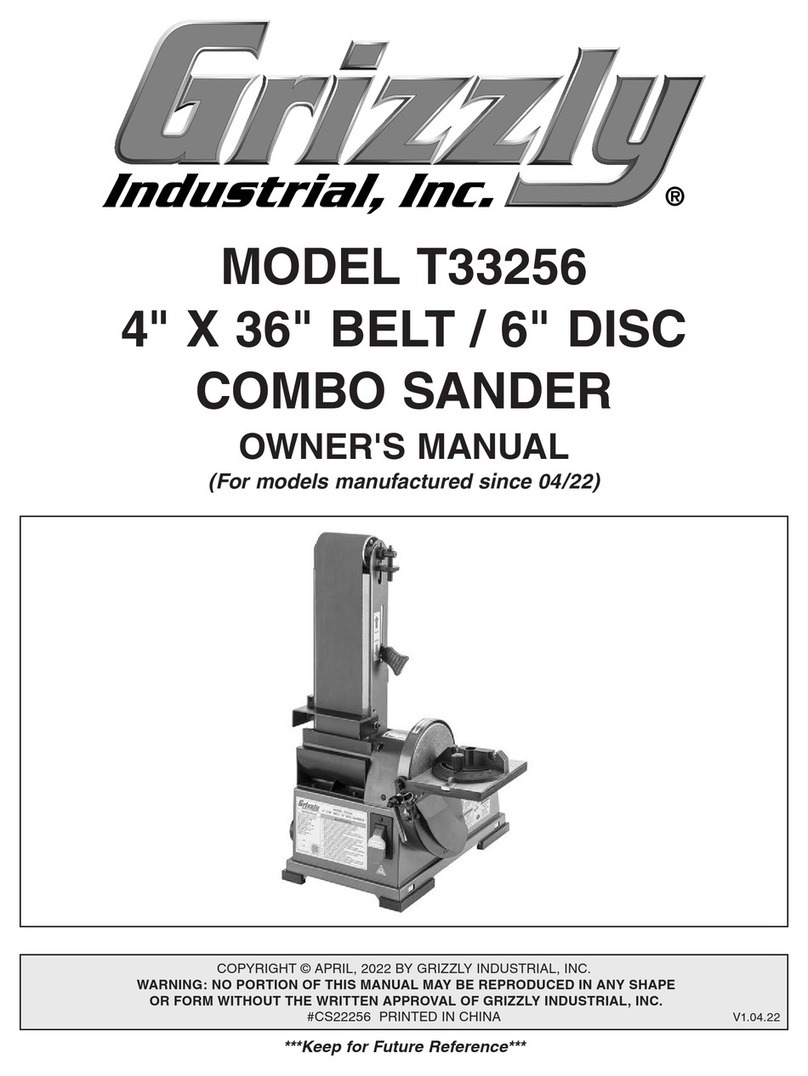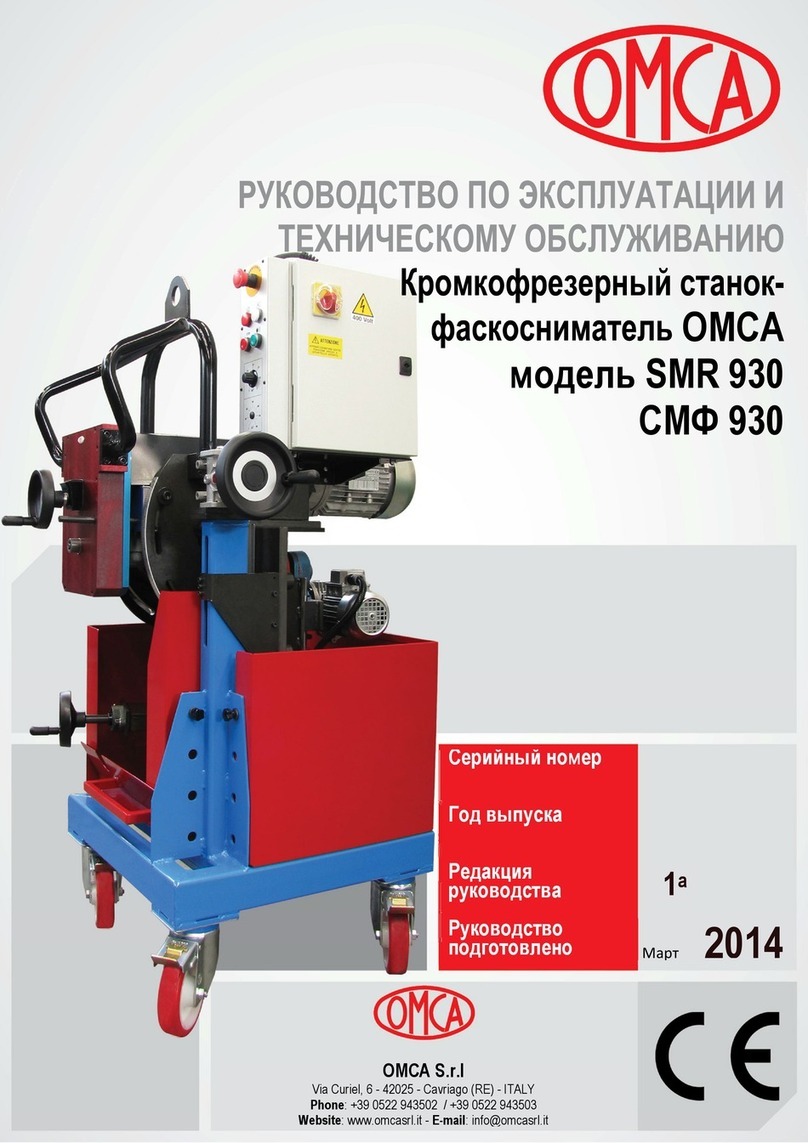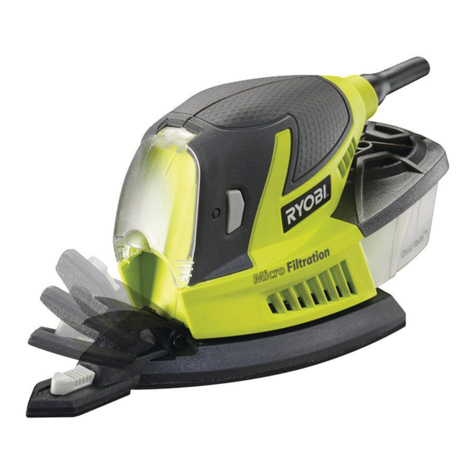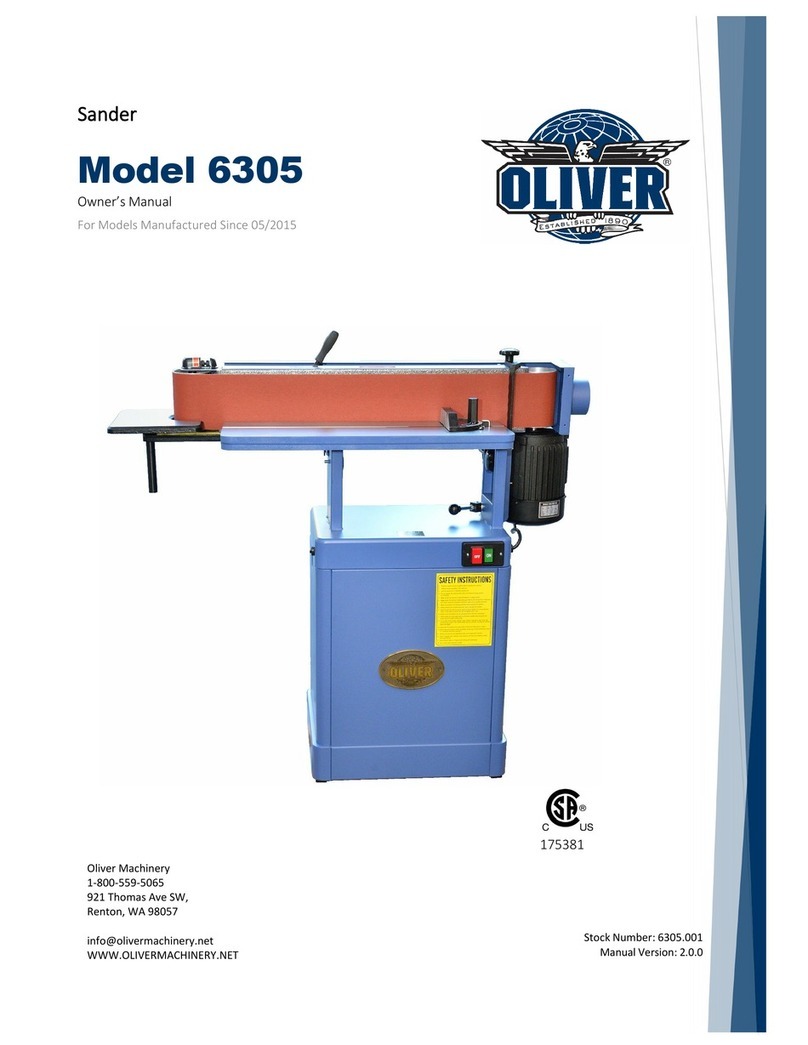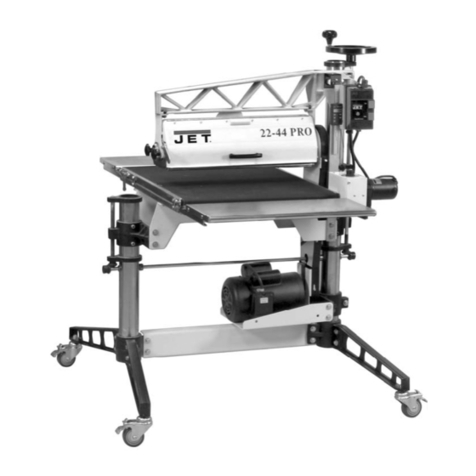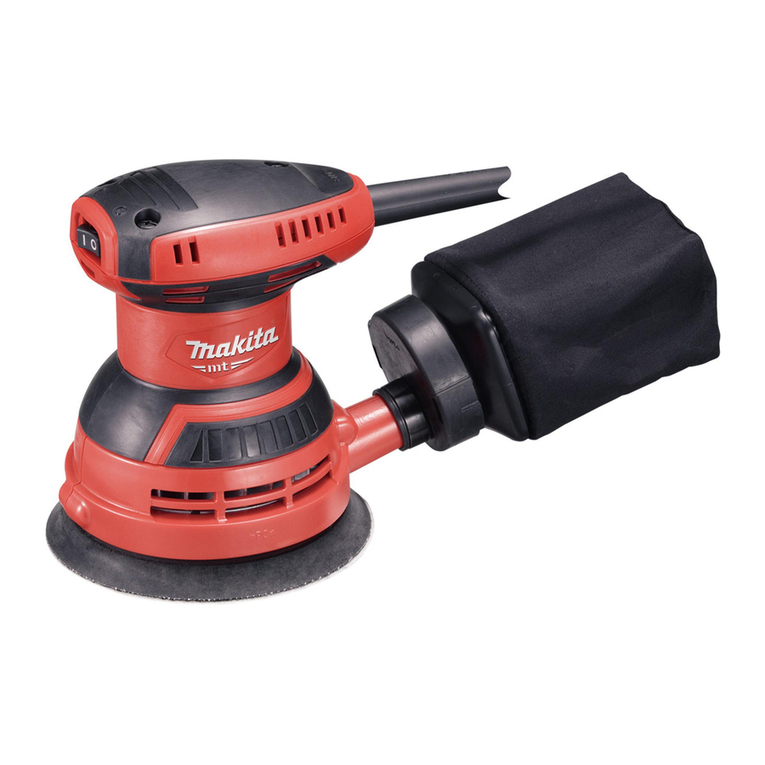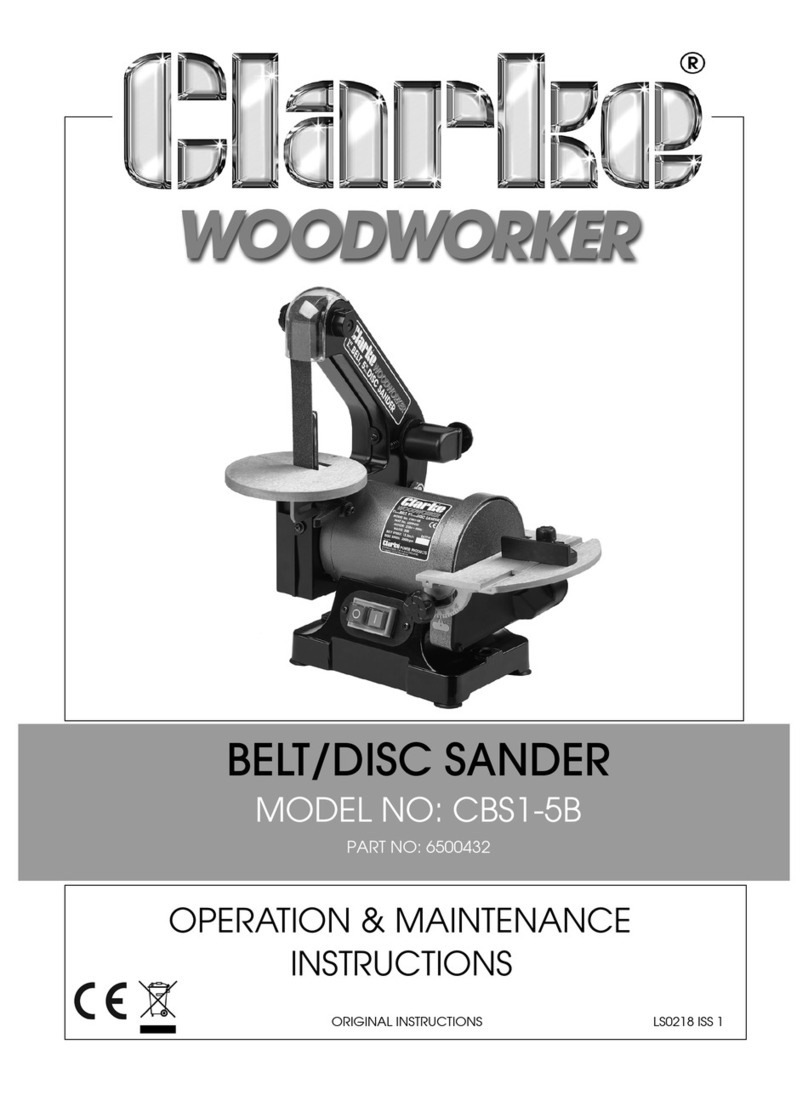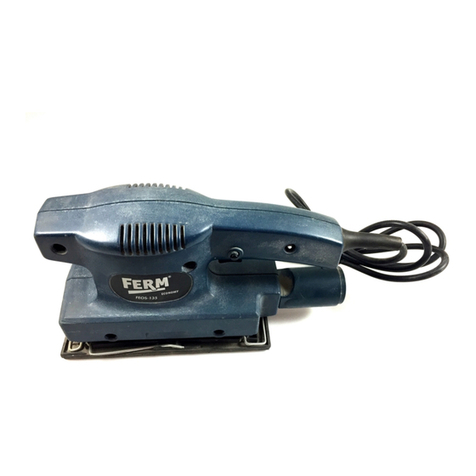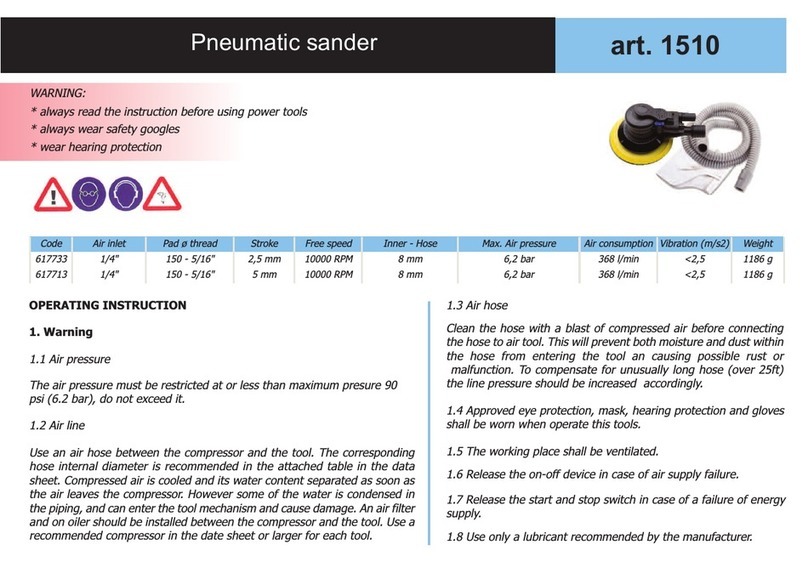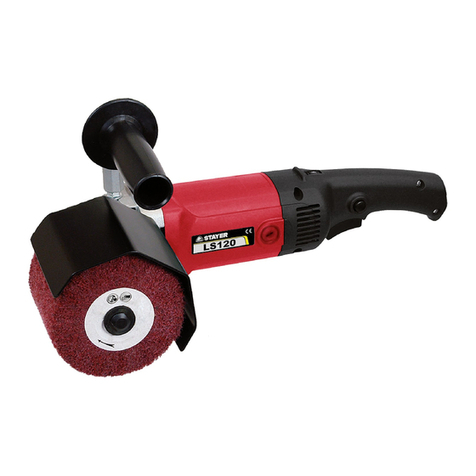
260W Power Belt File 13mm
5
Evenwhenusedasprescribeditisnotpossibletoeliminateallresidualriskfactors.Usewith
caution.Ifyouareatallunsureofthecorrectandsafemannerinwhichtousethistool,donot
attempt to use it.
General Power Tool Safety Warnings
WARNING: Read all safety warnings, instructions, illustrations and specications
provided with this power tool. Failuretofollowallinstructionslistedbelowmayresultinelectric
shock,reand/orseriousinjury.
Save all warnings and instructions for future reference.
Theterm“powertool”inthewarningsreferstoyourmains-operated(corded)powertoolorbattery-
operated(cordless)powertool.
1) Work area safety
a) Keep work area clean and well lit.Cluttered or dark areas invite accidents.
b) Do not operate power tools in explosive atmospheres, such as in the presence of
ammable liquids, gases or dust.Powertoolscreatesparkswhichmayignitethedustor
fumes.
c) Keep children and bystanders away while operating a power tool.Distractions can cause
youtolosecontrol.
2) Electrical safety
a) Power tool plugs must match the outlet.Never modify the plug in any way. Do not use
any adapter plugs with earthed (grounded) power tools. Unmodiedplugsandmatching
outletswillreduceriskofelectricshock.
b) Avoid body contact with earthed or grounded surfaces, such as pipes,radiators, ranges
and refrigerators. Thereisanincreasedriskofelectricshockifyourbodyisearthedor
grounded.
c) Do not expose power tools to rain or wet conditions. Waterenteringapowertoolwill
increase the risk of electric shock.
d) Do not abuse the cord. Never use the cord for carrying,pulling or unplugging the power
tool. Keep cord away from heat,oil, sharp edges or moving parts. Damaged or entangled
cords increase the risk of electric shock.
e) When operating a power tool outdoors, use an extension cord suitable for outdoor use.
Use of a cord suitable for outdoor use reduces the risk of electric shock.
f) If operating a power tool in a damp location is unavoidable, use a residual current device
(RCD) protected supply.Use of an RCD reduces the risk of electric shock.
3) Personal safety
a) Stay alert, watch what you are doing and use common sense when operating a power
tool. Do not use a power tool while you are tired or under the inuence of drugs, alcohol
or medication. Amomentofinattentionwhileoperatingpowertoolsmayresultinserious
personalinjury.
b) Use personal protective equipment. Always wear eye protection. Protective equipment
suchasadustmask,non-skidsafetyshoes,hardhatorhearingprotectionusedforappropriate
conditionswillreducepersonalinjuries.
c) Prevent unintentional starting.Ensure the switch is in the OFF-position before connecting
to power source and/or battery pack, picking up or carrying the tool.Carryingpower
toolswithyourngerontheswitchorenergisingpowertoolsthathavetheswitchONinvites
accidents.
d) Remove any adjusting key or wrench before turning the power tool ON.Awrenchorakey
leftattachedtoarotatingpartofthepowertoolmayresultinpersonalinjury.
e) Do not overreach. Keep proper footing and balance at all times. This enables better control
ofthepowertoolinunexpectedsituations.
f) Dress properly. Do not wear loose clothing or jewellery. Keep your hair and clothing away
from moving parts. Looseclothes,jewelleryorlonghaircanbecaughtinmovingparts.
g) If devices are provided for the connection of dust extraction and collection facilities,
ensure these are connected and properly used. Use of dust collection can reduce dust-related
hazards.
h) Do not let familiarity gained from frequent use of tools allow you to become complacent
and ignore tool safety principles.Acarelessactioncancausesevereinjurywithinafractionofa
second.
4) Power tool use and care
a) Do not force the power tool. Use the correct power tool for your application.The correct
powertoolwilldothejobbetterandsaferattherateforwhichitwasdesigned.
b) Do not use the power tool if the switch does not turn it ON and OFF. Anypowertoolthat
cannotbecontrolledwiththeswitchisdangerousandmustberepaired.
c) Disconnect the plug from the power source and/or remove the battery pack,if detachable,
from the power tool before making any adjustments, changing accessories,or storing
power tools. Suchpreventivesafetymeasuresreducetheriskofstartingthepowertool
accidentally.
d) Store idle power tools out of the reach of children and do not allow persons unfamiliar
with the power tool or these instructions to operate the power tool. Powertoolsare
dangerous in the hands of untrained users.
e) Maintain power tools and accessories. Check for misalignment or binding of moving
parts, breakage of parts and any other condition that may affect the power tool’s
operation. If damaged, have the power tool repaired before use. Manyaccidentsarecaused
bypoorlymaintainedpowertools.
f) Keep cutting tools sharp and clean. Properlymaintainedcuttingtoolswithsharpcuttingedges
arelesslikelytobindandareeasiertocontrol.
g) Use the power tool, accessories and tool bits,etc. in accordance with these instructions,
taking into account the working conditions and the work to be performed. Use of the
powertoolforoperationsdifferentfromthoseintendedcouldresultinahazardoussituation.
h) Keep handles and grasping surfaces dry, clean and free from oil and grease. Slippery
handlesandgraspingsurfacesdonotallowforsafehandlingandcontrolofthetoolin
unexpected situations.
5) Service
a) Have your power tool serviced by a qualied repair person using only identical
replacement parts.Thiswillensurethatthesafetyofthepowertoolismaintained.
Specic Safety
Sanding Tool Safety
WARNING!
• Hold the power tool by insulated handles or gripping surfaces only,because the sanding
belt/sheet may contact its own cord.Cuttinga"live"wiremaymakeexposedmetalpartsof
thepowertool‘live’andcouldgivetheoperatoranelectricshock.
• Use clamps or another practical way to secure the workpiece to a stable platform. Holding
theworkpiecebyhandoragainstthebodymakesitunstableandmayleadtolossofcontrol.
• Recommendation that the tool always be supplied via a residual current device with a
rated residual current of 30 mA or less.
• If the replacement of the supply cord is necessary, this has to be done by the
manufacturer or his agent in order to avoid a safety hazard.
a. ALWAYS wear appropriate protective equipment, including a dust mask with a minimum
FFP2 rating, eye protection and ear defenders
b. Ensure all people in the vicinity of the work area are also equipped with suitable personal
protective equipment
c. Take special care when sanding some woods (such as beech,oak, mahogany and teak), as
the dust produced is toxic and can cause extreme reactions
d. NEVER use to process any materials containing asbestos. Consult a qualied professional,
if you are uncertain whether an object contains asbestos
e. DO NOT sand magnesium or alloys containing a high percentage of magnesium
f. Be aware of paint nishes or treatments that may have been applied to the material that
is being sanded. Many treatments can create dust that is toxic, or otherwise harmful. If
workingonabuildingconstructedpriorto1960,thereisanincreasedchanceofencountering
lead-based paints
g. The dust produced when sanding lead-based paints is particularly hazardous to children,
pregnant women, and people with high blood pressure.DONOTallowthesepeoplenearto
theworkarea,evenifwearingappropriatepersonalprotectiveequipment
h. Whenever possible, use a vacuum dust extraction system to control dust and waste
i. Be especially careful when using a machine for both wood and metal sanding. Sparks
from metal can easily ignite wood dust. ALWAYScleanyourmachinethoroughlytoreducethe
riskofre
j. Empty the dust bag or container (where applicable) frequently during use, before taking
breaks and after completion of sanding.Dustmaybeanexplosionhazard.DONOTthrow
sandingdustintoanopenre.Spontaneouscombustionmayoccurwhenoilorwaterparticles
comeintocontactwithdustparticles.Disposeofwastematerialscarefullyandinaccordancewith
locallawsandregulations.
k. Work surfaces and sandpaper can become very hot during use. If there is evidence of
burning (smoke or ash), from the work surface,stop and allow the material to cool. DO
NOTtouchworksurfaceorsandpaperuntiltheyhavehadtimetocool
l. DO NOT touch the moving sandpaper
m. ALWAYS switch off before you put the sander down
n. DO NOT use for wet sanding.Liquids entering the motor housing can cause severe electric
shocks
o. ALWAYS unplug the sander from the mains power supply before changing or replacing
sandpaper
p. Even when this tool is used as prescribed it is not possible to eliminate all residual risk
factors. Ifyouareinanydoubtastosafeuseofthistool,donotuseit
247820/976084_Manual.indd 5 12/08/2019 11:35





